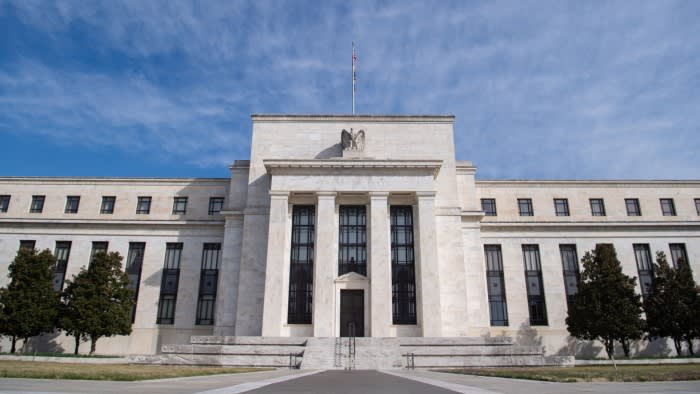Unlock the White House Watch newsletter for free
Your guide to what the 2024 US election means for Washington and the world
Investors called this US election correctly, the result is swift and unambiguous, and it bakes in American exceptionalism. All of that is good news for US stocks. But sliding bonds are an ominous sign of the simmering tension over debt levels that Donald Trump’s victory brings.
Some last-minute doubt and an iffy Iowa opinion poll notwithstanding, for weeks the message from markets had been a clear conviction that the former president would cruise his way back to the White House.
The evidence for that certainty was dotted in various places around global markets. In the round, Trump’s economic agenda points to tax cuts and continued high spending, plus large tariffs on imports and a squeeze on labour supply through a process one fund manager recently diplomatically described to me as “de-immigration”. All of that is inflationary.
This is a drag on bonds, which are never fans of rising prices due to their fixed returns, and which do well when interest rates are falling — a more complicated task for the Federal Reserve in the event that Trump’s policies rekindle those inflationary pressures. At the same time, though, it helps the dollar, which should be a beneficiary of higher-for-longer US interest rates and of import tariffs intended to dent American purchases of foreign goods. A broad platform of deregulation is also, all things being equal, good for stocks.
All of that had been playing out with considerable force since mid-September. Over that period, the dollar index had gained more than 3 per cent, even before the results of the election were known. Stocks had also ground out roughly 5 per cent gains in the benchmark S&P 500 index. At the same time, benchmark 10-year Treasury yields have swept up from around 3.6 per cent to around 4.3 per cent, reflecting a chunky drop in prices.
On Wednesday, as it became clear that Trump was on course to win, all of this accelerated markedly. In particular, US bond yields pushed higher again, and fast, taking benchmark yields to 4.46 per cent. Some context here matters. Yields were higher as recently as this summer. Still, this is shaping up to be one of the biggest jumps in US yields since the shortlived government bond crisis in the UK a little over two years ago. This, not stocks, is the shift to watch carefully.
Some of this is about the Fed. Can it keep on cutting rates, as it is expected to do again on Thursday, into next year, if Trump follows through on his tariff threats and jacks up inflation? “Will they be hiking next year? It’s a valid question to ask,” says Salman Ahmed, global head of macro at Fidelity International in London.
Some of it, though, is about even trickier issues around fiscal sustainability. Trump’s Democratic rival Kamala Harris was hardly a fiscal hawk — both candidates intended to keep on spending. But Trump’s willpower here is perceived to be weaker, and this downdraft on bond prices, if sustained, could send US borrowing costs spiralling higher. As German asset manager DWS put it, “The fear of a decline in fiscal discipline is likely to be particularly decisive”.
This is the bogeyman that has been haunting investors for years. At what point will investors say enough is enough on government spending and refuse to foot the bill, or at least demand much higher returns?
It is an age-old question that tends to ignite whenever bond prices are sliding for whatever reason, and whenever shifts in political direction occur. The final make-up of Congress will be key for investors now — a Republican clean sweep would remove any possibility of meaningful resistance to Trump’s agenda.
Money managers will now spend the coming months and years unpacking which bits of Trump’s campaign rhetoric on tariffs and taxes are for real, which are negotiating tactics with trade partners, and which are just locker room talk. The fact that benchmark yields have not blasted above 5 per cent suggest bondholders believe at least some of it was for show. Trump’s pick of Treasury secretary will be key.
While those details are thrashed out, though, something else sticks out: while US yields are rising, those in the UK and Germany initially fell. “It’s very rare for that to happen,” said Ahmed at Fidelity International. “It tells you the market’s view is that growth will be transferred. Tariffs and fiscal policy are taking growth away from someone,” he said. China’s knee-jerk decline in stocks is also telling. America first is clearly in play.
Make no mistake: the bond vigilantes have woken up and taken note of Trump’s big win. This immediate drop in bond prices is alarming. Fiscal sustainability remains a serious concern, and investors will have a tough time unpicking this, and tariff policy, in the coming months.
The counterbalance, though, is something even more powerful than the bond market: Trump’s ego. He loves winning, and he loves buoyant equities. With luck, that should restrain him from doing anything sufficiently disruptive on debt and inflation to upset stocks.
katie.martin@ft.com
https://www.ft.com/content/2e204e7c-6a00-412d-9c59-6bb815f0139a


